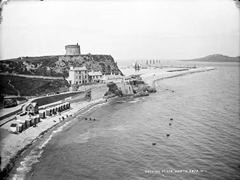Remembering Howth
 Peter Cheney looks back over the rapid turn of events in 1914.
Peter Cheney looks back over the rapid turn of events in 1914.
In the spring and summer of 1914, Irish unionists and nationalists alike were increasingly seeing the home rule crisis as intractable. Amid the rising tensions, the gunrunnings at Larne and Howth raised fears that Ireland was close to civil war.
The guns themselves were purchased by two determined figures: Fred Crawford (for the Ulster Volunteer Force) and Darrell Figgis (for the Irish Volunteers). Royal proclamations in December 1913 banned the importation and the “carriage coastwise” of arms, ammunition and arms components into Ireland. Fred Crawford subsequently bought 24,600 rifles and 3 million rounds of ammunition through Bruno Spiro, a private arms dealer in Hamburg.
The Royal Irish Constabulary did not intervene when Crawford’s arms were landed in April 1914 although evidence was gathered with a view to prosecuting unionist leaders. Nationalists were angered but the UVF was still under-armed with only one in four of its members having a rifle.
A much smaller quantity of weaponry (1,500 rifles and 45,000 rounds) was bought by Figgis at Hamburg. The supplier was understood to be Moritz Magnus and these were transferred in the North Sea to two yachts, the Asgard and the Kelpie.
The Asgard landed on Howth harbour in daylight on 26 July and its 900 guns were transported away by supporters. British troops sent to retrieve the guns returned to barracks and fired on protestors at Bachelor’s Walk. Three civilians died and one man died later of his injuries. The soldiers were later censured by a commission of inquiry.
The Kelpie transferred its 600 guns to another yacht, the Chotah, which quietly landed them at Kilcoole, County Wexford, on the night of 1-2 August. Attention, though, quickly turned to the escalating crisis in Europe. Within days, Britain was at war and within weeks, Irish soldiers – from both communities – would be joining up to fight Germany rather than each other at home.
Some of the Howth guns were used in the Easter Rising. The Larne guns were stored during the war and later released to the Northern Ireland Government’s security forces. Bruno Spiro continued as a private arms dealer after the war but was arrested in 1936 for smuggling and tax fraud. A Jew, he was imprisoned in a concentration camp near Hamburg where he died in September of that year.
Magnus’ business was dissolved in 1939 as his daughter was married to a Jew. He and his family were then deported to Auschwitz in 1944 and nothing further was heard of them. While the Asgard is now preserved at Collins Barracks, the main UVF boat – the Clyde Valley – was scrapped in Lancashire in 1974 after restoration attempts ran out of funds.
Moderate perspectives from the time are often overlooked. Some Protestant clergy objected to the militant tone within unionism and the mainstream nationalist leadership, under John Redmond, was pursuing its aims through Parliament.
In return for the passing of the home rule legislation on 18 September, Redmond pledged the Irish Volunteers’ support for Britain soon two days later. His Woodenbridge speech committed Ireland “to the best of her ability to go wherever the firing line extends, in defence of right, of freedom and of religion in this war.”
Most signed up but, to Redmond’s regret, almost 49,000 lost their lives as the war stretched on. John Bruton – an admirer of Redmond and his parliamentary tradition – has added to the historical debate by calling for an honest reassessment of the gunrunning episodes and subsequent conflicts.
The view that home rule would have developed into independence without 5,700 deaths does have a right to be heard although the alternative course of history is by no means certain. Constitutionalism was quickly overtaken by the Rising and the events of 1916 proved to be the most decisive points in early 20th century Irish history, with reverberations which continue to the present day.





